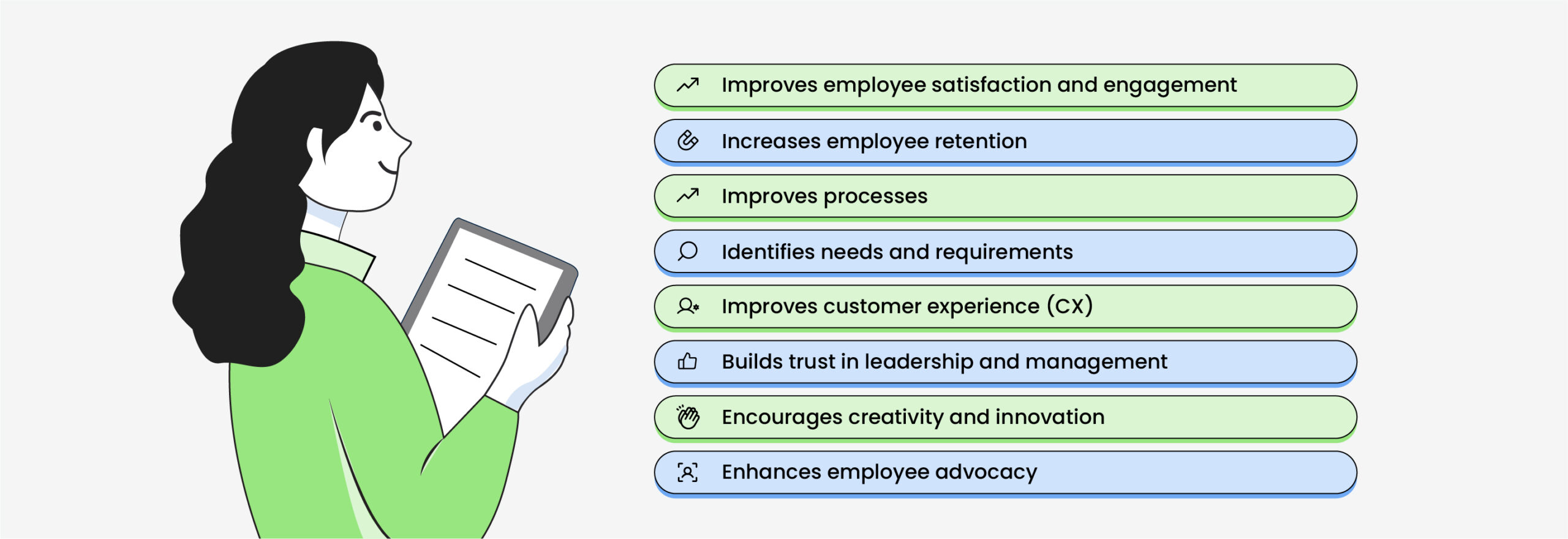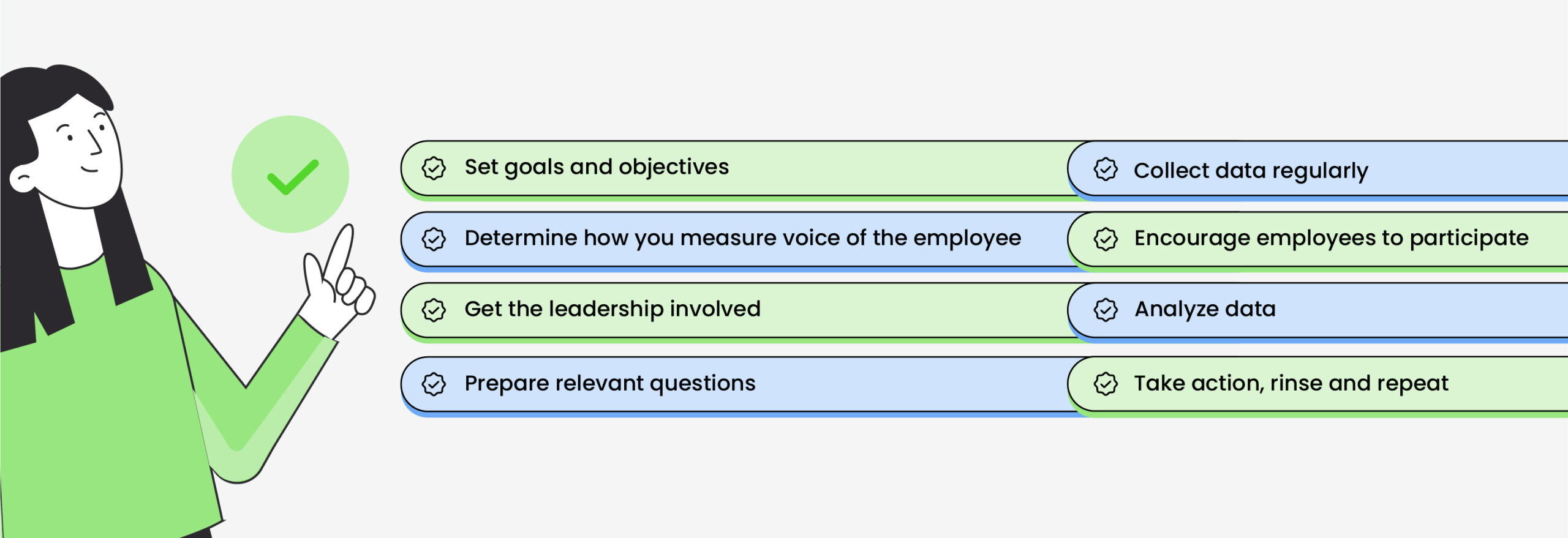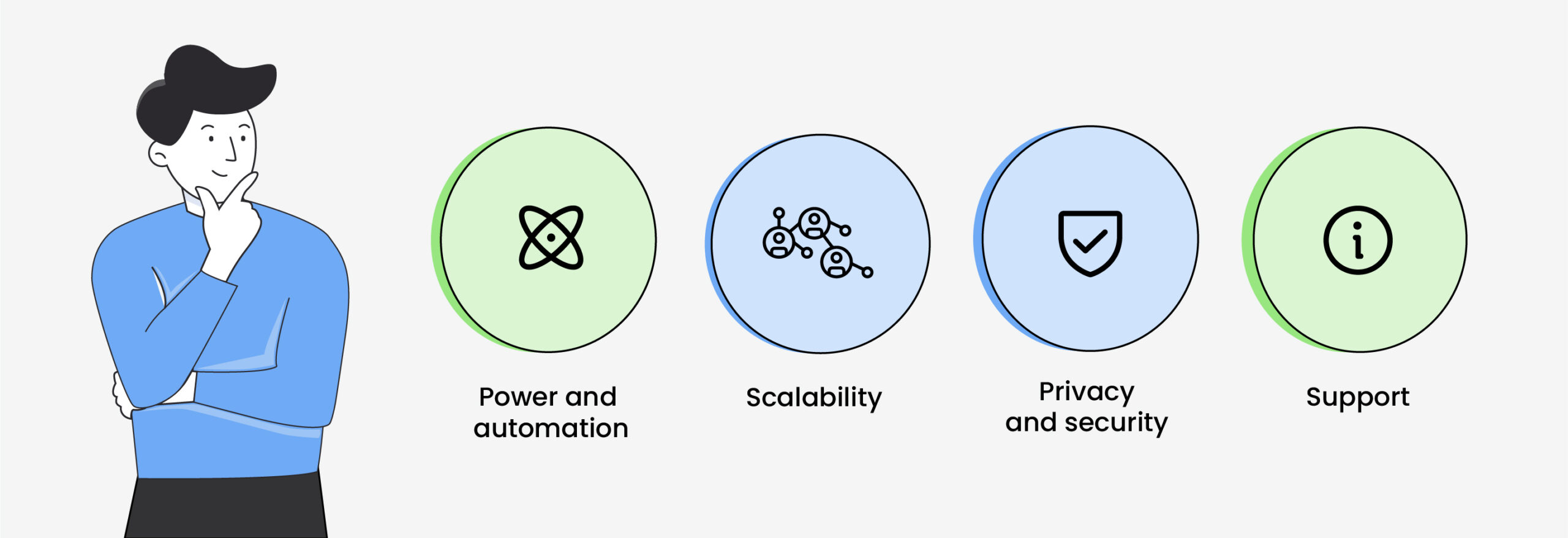Companies listen to their consumers to understand their experience and expectations to improve their product or service.
But what about listening to employees to improve their experience?
If your employees are uncomfortable expressing their opinions, you may miss crucial insights regarding customer needs, workplace challenges, and other aspects that impact your growth.

That’s why giving your employees a voice and measuring feedback is essential.
In this blog, we will discuss the value of employee voice, how to implement it, and everything in between.
What is the voice of the employee?
Voice of employee or VoE involves collecting feedback from employees so that they can express their ideas, suggestions, grievances, and needs at the workplace. This includes goals to improve employee experience, enhance workplace culture, boost productivity, collect out-of-the-box ideas, refine business processes, raise concerns, and much more.

What is a voice of employee program?
A voice of employee program aims to improve employee experience and satisfaction by giving them the chance to express their ideas and opinions about the company. Employees must be able to voice what they feel and want, and such initiatives help employees feel like an important part of the organization’s growth.
Some companies conduct anonymous surveys as a part of the VoE program to give employees a platform to raise their concerns comfortably. This enables them to honestly express their opinion about the company.
What is the importance of the voice of employees?

Enforcing a proper ‘voice of employee’ program can prove to be a tricky undertaking. But the many benefits indeed surpass the troubles of creating one. The following points show the importance of employee voice in the workplace:
1. Improves employee satisfaction and engagement
According to Forbes, employees who feel their voices are heard are 4.6 times more likely to produce their best work. One of the most visible and significant benefits of the voice of employees is improved employee engagement and satisfaction. VoE programs help understand the factors that are making employees unhappy and enable the leadership to take quick action for rectifying them.
When your employees see that you not only attempting to collect their feedback but also taking proactive action to work on them, they feel valued. Voice of employee programs help build a better workplace and drive employees to be more engaged. And, an engaged workforce improves business performance, increases sales, boosts revenue, and enhances company culture.
2. Increases employee retention
VoE programs can be instrumental in evaluating the happiness score of every employee. You can take effective measures for employees with low happiness scores. This would address their issues and incentivize employees to stay at your company.
Engaged employees are more likely to stay with their organization, reducing overall turnover and costs. They feel a stronger bond to their organization’s mission and purpose and promote the company to others.
According to statistics, 72% of workers cited corporate culture influencing their decision to work at a company. Voice of employees enables you to remove factors that affect the well-being of employees in a workplace and improve the employee retention rate.
3. Improves processes
When employees know their seniors hear them, they’re more open to sharing ideas, knowledge, and skills. Not only does this help you identify engagement opportunities and areas for improvement, but it also encourages knowledge transfer and skill-sharing.
Employee feedback also enables you to identify inefficiencies in your processes and redesign them for better productivity. Be it onboarding or performance management; your employees are the ones who go through these processes and, thus, are more equipped to provide valuable observations to boost efficiency.
Suppose your organization’s VoE program includes a post-onboarding survey to gather data on the onboarding experience of your new hires. After analysis, if the survey results show that your employees find the first-day job orientation confusing, you can take it as a concrete signal to review your job orientation process and implement changes.
4. Identifies needs and requirements
Understanding and providing for the needs of employees is essential for company morale, productivity, and success. Meeting employee needs is a deciding factor in the productivity rate of your company. Considering employee voice programs give your people the chance to express their grievances and demands freely.
Voice of the employee program drives better communication at the workplace and allows leaders to listen to the changing needs of their employees directly. The data you collect from employee voice surveys can show what changes and solutions you need to bring regarding employee training, infrastructure, working hours, etc.
5. Improve customer experience (CX)
It is critical to listen to your customer-facing teams. Their insights regarding what the customer needs and expects from your brand are valuable. Their interactions give them a better idea of customer experience.
Collecting these insights from customer-facing teams can help your company better understand the customers. You can include these findings in your operations and training to equip your company and employees to serve customers efficiently.
6. Builds trust in leadership and management
Employees’ level of trust and confidence in management is visible when they can speak up freely with their employers, irrespective of their positions. Putting effort into employee voice programs reveals that you value their contributions and insights.
Taking proactive measures to work on the gathered insights reflects your commitment to enhancing employee happiness in the workplace. This builds trust in the management and leadership and gives your employees the confidence to express their honest opinion.
7. Encourages creativity and innovation
Every employee can be a unique driver of growth with their diverse skill sets. Their unique experiences enable them to develop outstanding solutions that often effectively solve problems. Also, it helps the management and leadership to identify suitable employees for essential tasks based on their creativity and skill set.
Voice of the employee program makes your employee more confident in asking questions, which drives them to learn more about their role, team, and organization. When they have a thorough understanding of the company’s operations, it enhances their creative abilities. Your employees won’t hesitate to bring out-of-the-box ideas to the table. VoE incentivizes employees to go beyond their job roles and be innovative.
8. Enhances employee advocacy
When you create a healthy work culture for your employees, it encourages them to drive employee advocacy. They are more willing to promote your organization to others via social media or in person. This significantly reflects the unity and trust between employers and employees at your company.
When their leaders listen to what employees say within the organization, they view themselves as an integral part of it. This intrinsically encourages them to stand up for their organization when the time comes. Apart from that, a proper VoE program positively impacts employer branding, which again helps in attracting the best talents for work.
How to listen to employees’ voices at work?

To properly listen to employees’ voices, specific mechanisms should be in place to help employers keep track of the issues in the workplace. Modern companies widely use the following means to establish that there’s always someone to hear what the employees say.
1. Employee feedback
Your employee feedback surveys should include general questions related to workplace assets. You can ask them questions about their opinions on the amenities and any issues they might face, particularly about their work and workplace. This will summarize the pain points and reveal where you need to pay attention before diving deeper into the critical issues.
2. Employee engagement surveys
You can leverage employee engagement surveys to measure employees’ motivation and dedication toward their work. It helps narrow down the issues affecting their productivity and morale and identifies what stops them from achieving their best performance. Issues like poor communication, team problems, relationships with the management, etc., can be identified through the collected data.
Employee engagement surveys also give you the chance to gather valuable insights and act on rectifying the issues. This makes your employees feel confident in the management and encourages them to share their views and concerns openly.
3. One-on-one meetings
These discussions encourage workers to speak up and be open about their issues in a detailed manner. It also helps the managers to understand the employees properly. This way, they can put forward personalized suggestions.
If you implement one-on-one meetings at your organization, consider starting an open-door policy so that employees can confidently approach you whenever they need.
4. Suggestion box
While quite traditional, suggestion boxes are a very effective way to help the employees speak out. The suggestions and opinions gathered through this method are likelier, as it provides the employees complete anonymity.
The suggestion boxes enable your workforce to point their management’s attention toward any ongoing problems, and ensure timely intervention and stop them from escalating further. It gives the employees who genuinely care about their organization a medium to voice their opinions without fearing judgment from their peers and employers.
List of employee voice best practices

If you have reaped the benefits of VoE by implementing your program, consider the following points for a more effective and seamless process:
1. Set goals and objectives
Before you decide on a voice of the employee strategy for your organization, it is vital to have a clear idea of what you want to achieve through this program.
While the overall goal is shared, every company’s requirements are different, and thus, objectives can be different.
Start with setting a definitive goal based on what you want to achieve. For example, if your goal is to improve your onboarding process and training module, your VoE program should focus on employee onboarding surveys. Whatever your goal may be, make it a point to structure your employee voice program around it.
2. Determine how you measure the voice of the employee
There are multiple ways to gather employee voice data and measure it — an employee survey is the most common method. Most companies rely on such surveys to collect and analyze the employee voice with quantitative data.
Employee surveys not only ask questions that determine how committed employees are to helping their companies achieve their goals but also analyze whether employees enjoy their job. Employee exit surveys give the company actionable insight into the drivers of employee turnover.
Employee engagement platforms are also an effective way to collect quantitative data on employee voice.
For qualitative data, group discussions and interviews can give valuable insights. You can also add text-based feedback from other channels, such as social media posts, Glassdoor reviews, emails, internal communications channels, etc.
Remember, the bottom line is to choose a method that aligns with your business’s objectives, available infrastructure, and workforce size.
3. Get the leadership involved
While you settle on a VoE program structure, keep the leadership in the loop. This will help you get top-tier approvals quickly and eliminate any roadblocks related to resources.
4. Prepare relevant questions
While preparing the survey questionnaire, include both open-ended and closed-ended questions. While close-ended questions with a numerical rating scale generate quicker and increased participation, open-ended questions can give you better insights about qualitative measures and gather unique employee insights. Thus, a healthy balance of both will drive better results.
5. Collect data regularly
To see impactful and positive changes through your VoE program, make sure it doesn’t turn out to be a one-time initiative. The smart way to approach it is to plan the data collection.
The ideal interval should be every 3 to 6 months with a quick pulse survey. This way, you can track even the subtle changes and take action before any issue escalates. Implementing such a strategy ensures seamless and constantly improving operations in the company.
However, manual data collection can not be effectively frequent and accurate. Here, automating the data collection is a great way to keep the cycle running smoothly and process data more accurately.
Leena AI provides best-in-class automation software that will distribute surveys at regular intervals and collect data with precision. The conversation AI-powered system also helps avoid survey fatigue by strategically planning survey frequency.
6. Encourage employees to participate
The biggest issue with conducting employee surveys is the low participation rate. Filling out survey forms after working long hours can be frustrating. To avoid that, companies can incentivize employees to drive more participation.
Awareness of the necessity of employee surveys is also an excellent way to increase participation. The incentive here is not monetary. When employees realize that leaders are acting on their concerns, they will put in the effort and participate.
7. Analyze data
Once you’ve collected the data, it is time to conduct your analysis. Companies implementing VoE programs use various processes to gather and analyze employee feedback. Data sources include surveys, employee NPS, performance evaluations, employee forums, social networks, focus groups, and exit interviews.
However, processing large amounts of data without adequate technology is hugely laborious. Results are likely to be inaccurate and, thus, may lead to the program falling flat. Besides, employee data can be primarily unstructured and tricky to analyze on a large scale. You need to improve your company’s digital dexterity to have the best results.
Besides quantitative insights, Leena AI’s technology dives deep into employee feedback and presents you with qualitative measures through sentiment analysis.
8. Take action, rinse and repeat
The results of data analysis will show you the way, but taking prompt action is your responsibility. Your voice of the employee program can only be successful when you take proactive initiatives to work on the suggestions.
You must be creative and develop innovative ideas to solve the identified problems. If you track the lack of synergy among team members, develop ways to foster mutual trust and improve interdepartmental communication. If your exit interview shows a lack of opportunity as a pain point, try improving internal mobility through various initiatives.
Questions for your voice of employee survey
The questions you add to your employee surveys can make or break your employee voice program. Here are some questions you can add to your company’s employee surveys:
- How proud are you of working in this organization?
- How often does your manager provide performance feedback?
- How happy are you with your role and responsibilities?
- How motivated are you to complete your work assignments on time?
- Do the organization’s goals align with your professional goals?
- Do you have a clear idea of the organization’s expectations of you?
- Does the organization provide adequate resources and tools to complete your tasks successfully?
- Do you enjoy working with your team?
- Are you satisfied with the time you give to finish the tasks?
- Do you feel motivated to come to work every day?
However, to run these employee surveys and analyze data at a large scale effectively, you need a proper tool that ensures seamless processing.
How to choose a voice of employee tool?

Here are specific points you need to keep in mind before choosing a voice of employee tool for your company:
1. Power and automation
Some VoE tools offer limited features like basic document-level text analytics from limited data sources. You may get an overall sentiment evaluation score for an employee’s survey response, but you won’t have the hows and whys of the results.
Tools equipped with specialized VoE systems use complex NLP functions like multi-layered sentiment analysis to generate accurate and valuable insights into the sentiments of your employees, how they feel about those subjects, and why they think that way. The software with AI-powered technology also offers automation for accurate data collection.
2. Scalability
Choose a tool that could accommodate your company’s needs as it grows. You don’t want a fixed-sized solution that does not offer scalability, as it would eventually need replacing. Instead, go with a tool that grows with you.
3. Privacy and security
Data regulations are getting stricter every day, and with that, there is an increased need to choose a tool that provides robust data security and compliance—your chosen system to store your data and encrypt sensitive or identifying information safely.
4. Support
As VoE tools are a recent addition in most companies, you will need tech support frequently. Apart from that, business tools are better with customization. Hence, choose a VoE tool that provides 24X7 support for all your queries.
Conclusion
Your employees work to assist your customers. Hence, the happier employees are, the better they perform in their jobs, increasing revenue and growth for your company.
Employee voices show you precisely what you need to enhance employee experience.
But for your VoE program to work, you need a tool that fosters seamless processing and provides all-around security and support. Leena AI’s virtual assistant and automation software provides you with all that and much more. Its surveys with high engagement rates, automation, and sentiment analysis will help you revolutionize your VoE program in no time.
Empower Your Employees' Voice With Leena AI
Schedule a demo todayFrequently Asked Questions
What are the types of employee voices?
There are several types of employee voices, including:
- Formal voice: This is the traditional way that employees communicate with their employer, through channels such as meetings, performance evaluations, and email.
- Informal voice: This is when employees communicate with their employer through informal channels, such as casual conversations, social media, or employee forums.
- Collective voice: This is when employees come together as a group to advocate for a specific cause or issue. This can include unionization, worker committees, or other forms of collective action.
- Silent voice: This is when employees do not feel comfortable speaking up or expressing their opinions, either because they fear retaliation or because they do not believe their voices will be heard.
- Amplified voice: This is when employees use their position or platform to amplify the voices of others, such as by using social media to raise awareness of an issue or by speaking out on behalf of a group.
How do you give an employee a voice?
There are several ways to give employees a voice in the workplace:
- Encourage open communication: Create an open and inclusive culture where employees feel comfortable expressing their opinions and ideas. This can be done through regular one-on-one meetings, town hall meetings, or employee forums.
- Listen actively: When employees speak up, make sure to listen actively and attentively. This includes asking questions, paraphrasing, and acknowledging their concerns.
- Provide feedback: Give employees feedback on their ideas and suggestions, whether positive or constructive. This helps them feel heard and valued.
- Empower employees: Give employees the freedom and autonomy to make decisions and solve problems on their own. This helps them feel more invested in their work and gives them a sense of ownership over their contributions.
- Foster collaboration: Encourage teamwork and collaboration, as this helps create a sense of community and belonging among employees. By working together, employees can contribute their unique perspectives and ideas to the team.
What are the elements of employee voice?
The elements of employee voice refer to the various ways in which employees can express their opinions, ideas, and concerns in the workplace. These elements can include:
- Formal channels: such as meetings, performance evaluations, and email
- Informal channels: such as casual conversations, social media, or employee forums
- Collective action: such as unionization, worker committees, or other group efforts
- Amplification: using position or platform to amplify the voices of others
- Silent voices: employees who do not feel comfortable speaking up or expressing their opinions.
Does employee voice improve performance?
Yes, research has shown that employee voice can improve performance in the workplace. When employees feel that they have a say in how things are done and that their opinions are valued, they are more likely to be engaged and motivated in their work. This can lead to increased productivity, better decision-making, and improved organizational outcomes. Additionally, giving employees a voice can help to create a positive work culture, which can further contribute to improved performance.
What are the different benefits of employee voice?
There are several benefits of employee voice in the workplace, including:
- Increased engagement and motivation: When employees feel that they have a say in how things are done, they are more likely to be engaged and motivated in their work.
- Improved decision-making: Employees often have valuable insights and ideas that can contribute to better decision-making and problem-solving.
- Increased productivity: When employees feel empowered and have a sense of ownership over their work, they are likely to be more productive.
- Enhanced communication: Giving employees a voice can help to improve communication within the organization, fostering a sense of transparency and trust.
- Improved organizational outcomes: By fostering a positive and inclusive work culture, employee voice can lead to improved organizational outcomes such as increased customer satisfaction and higher profits.
What is employee voice, and why is it important?
Employee voice refers to the various ways in which employees can express their opinions, ideas, and concerns in the workplace. It is an important aspect of employee engagement and can have a significant impact on the performance and success of an organization. When employees feel that they have a say in how things are done and that their opinions are valued, they are more likely to be engaged and motivated in their work, leading to increased productivity and improved organizational outcomes.
Additionally, giving employees a voice can help to create a positive and inclusive work culture, fostering transparency and trust within the organization. Overall, employee voice is essential for ensuring that the needs and perspectives of all employees are heard and considered in the decision-making process.






